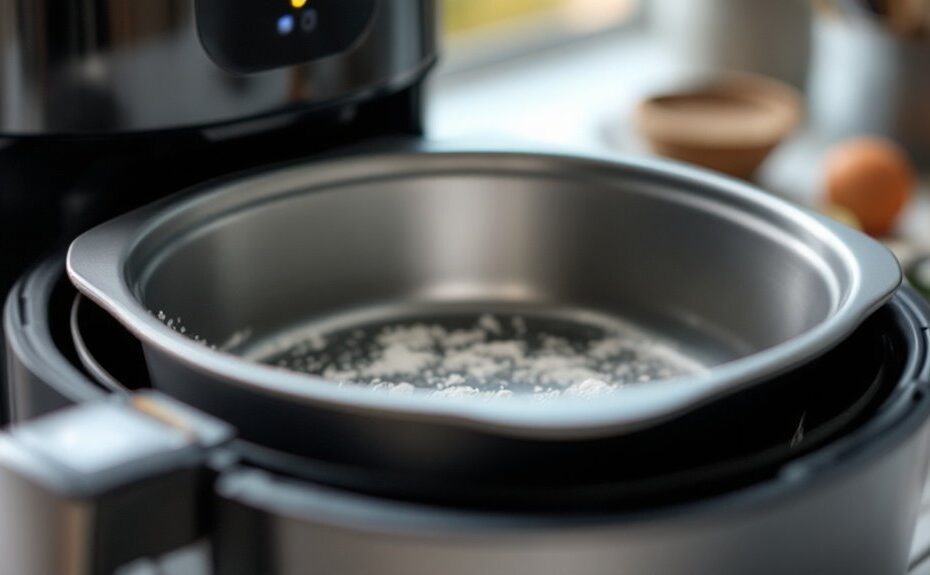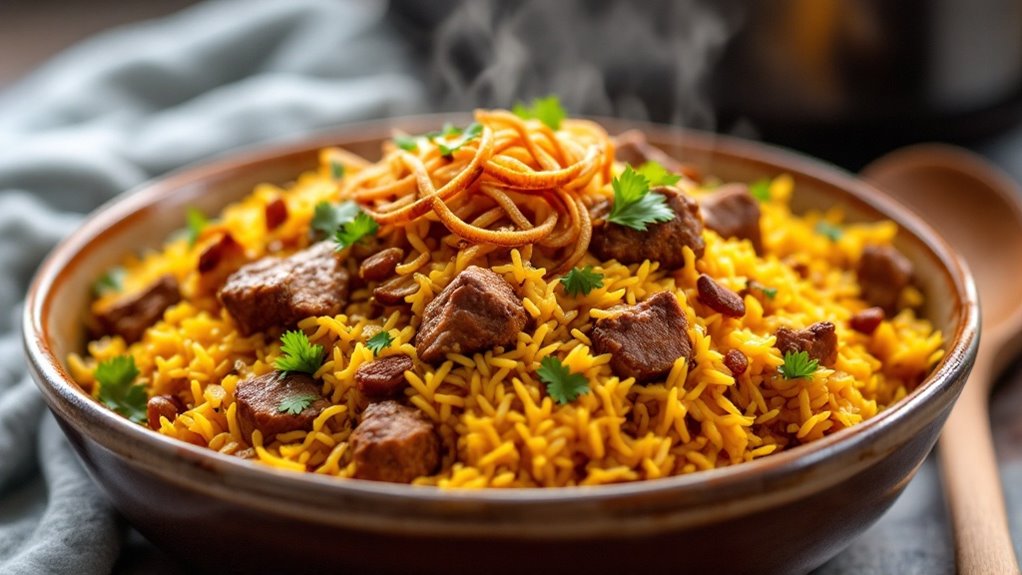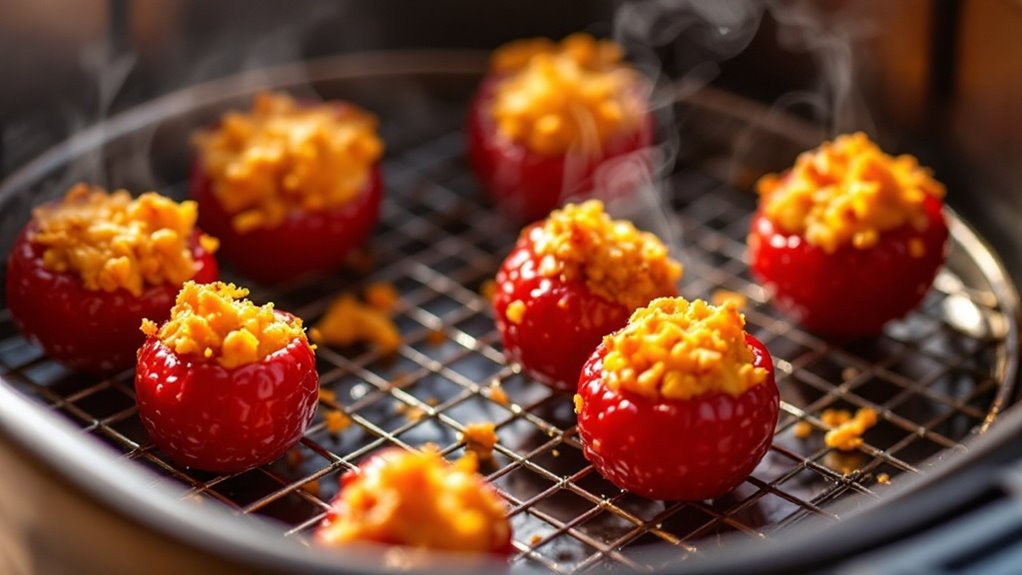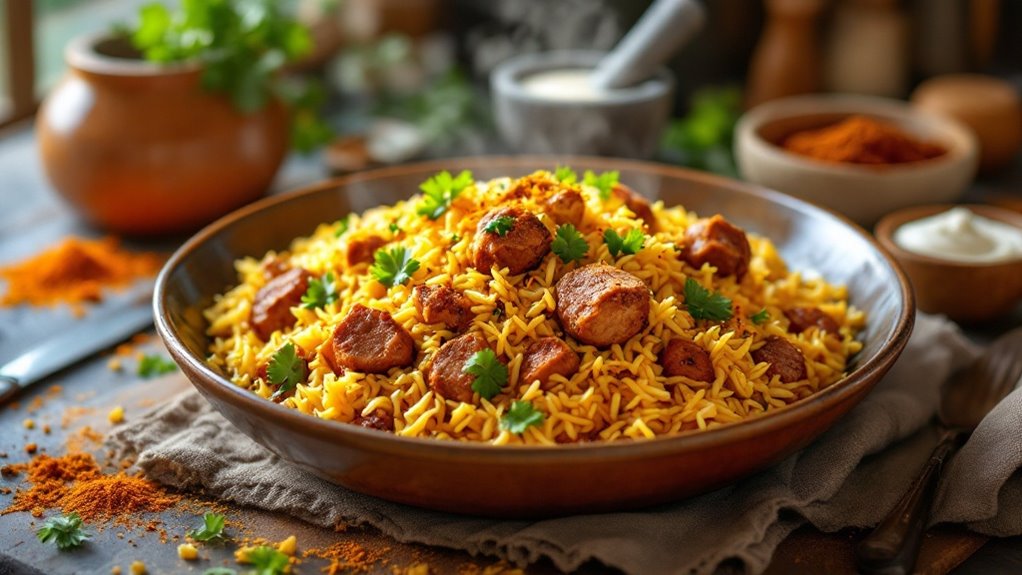You might think cooking with a baking pan in an air fryer is as impossible as frying ice, but it's not only possible—it's practical. The key lies in choosing the right pan and understanding how it interacts with your air fryer's unique cooking mechanics. You'll need to take into account materials, size, and airflow to avoid turning your meal into a disaster. But what happens if you get it wrong? And how can you maximize efficiency without sacrificing flavor? The answers could transform how you use your air fryer, so let's explore what you need to know to get started.
Key Takeaways
- Yes, you can use a baking pan in an air fryer if it fits the basket and is made of air fryer-safe materials like silicone or nonstick metal.
- Ensure the pan is heat-resistant, lightweight, and does not obstruct airflow or touch the heating element for safe cooking.
- Choose pans up to 7-8 inches in diameter or under 7 inches per side to fit properly and maintain efficient air circulation.
- Avoid overcrowding the pan and rotate food halfway through cooking for even heat distribution and optimal results.
- Always check the pan's maximum temperature rating and follow the air fryer's manual for compatibility and safety guidelines.
Understanding Air Fryer Compatibility
Before using a baking pan in your air fryer, confirm it's compatible with the appliance's size and material requirements. Measure the pan to guarantee it fits within the air fryer basket without obstructing airflow, as restricted circulation can compromise cooking performance and air fryer safety. Check the pan's height to avoid contact with the heating element, which could cause damage or pose a fire risk. Verify the pan material safety by confirming it can withstand high temperatures, typically up to 400°F (204°C). Avoid oversized or heavy pans that may strain the air fryer's motor. Always consult your air fryer's manual for specific guidelines on compatible accessories. Proper compatibility assures efficient cooking and reduces the risk of accidents or appliance damage.
Choosing the Right Baking Pan Material
When selecting a baking pan for your air fryer, prioritize materials that are heat-resistant, lightweight, and non-reactive. Opt for silicone, stainless steel, or aluminum pans, as they offer excellent heat conductivity and material safety. Silicone pans are flexible, easy to clean, and withstand high temperatures without warping. Stainless steel is durable and non-reactive, guaranteeing your food's flavor remains unaffected. Aluminum pans distribute heat evenly but should be coated or anodized to prevent reactions with acidic ingredients. Avoid non-stick coatings unless they're explicitly rated for high heat, as they can degrade and release harmful fumes. Always check the pan's maximum temperature rating to confirm it aligns with your air fryer's settings. Lightweight materials reduce strain on the air fryer basket and improve airflow for even cooking.
Size and Shape Considerations
Selecting the right size and shape for your baking pan guarantees it fits comfortably in your air fryer basket while allowing proper air circulation. Check your air fryer's manual for pan size limits to avoid overcrowding or blocking the heating elements. Most air fryers accommodate pans up to 7-8 inches in diameter or square pans under 7 inches per side. Avoid pans with high walls or irregular shapes, as they can cause shape compatibility issues, restricting airflow and uneven cooking. Opt for shallow, round, or rectangular pans that align with your air fryer's dimensions. Measure your basket's interior before purchasing a pan to confirm a snug fit without touching the sides. Proper sizing guarantees efficient cooking and prevents damage to your air fryer.
Heat Circulation and Cooking Efficiency
To guarantee even cooking and peak results in your air fryer, proper heat circulation is essential. Airflow optimization secures that hot air moves efficiently around your baking pan, preventing cold spots and uneven browning. Use a perforated or wire rack to elevate the pan, allowing air to flow underneath. Avoid overcrowding the pan, as it disrupts heat distribution patterns and reduces cooking efficiency. Opt for pans with low sides to maximize exposure to the circulating air. Rotate or shake the pan halfway through cooking to promote uniform heat exposure. Monitor the air fryer's temperature settings, as baking pans can slightly alter heat dynamics. By prioritizing airflow and heat distribution, you'll achieve consistent results and maintain the air fryer's rapid cooking capabilities.
Non-Stick vs. Traditional Bakeware
Non-stick bakeware guarantees easy food release and cleanup, making it ideal for delicate items like fish or pastries. Traditional bakeware, often made of stainless steel or cast iron, offers superior durability and heat retention for high-temperature cooking. Choose non-stick for convenience or traditional for longevity, depending on your cooking needs.
Non-Stick Surface Benefits
When using a baking pan in an air fryer, opting for a non-stick surface can simplify cleanup and prevent food from sticking, especially with delicate items like pastries or proteins. Make sure the non-stick coating is PFOA-free for non-stick safety, as harmful chemicals can degrade at high temperatures. To maintain non-stick longevity, avoid metal utensils or abrasive cleaners that scratch the surface. Instead, use silicone or wooden tools and hand wash with a soft sponge. Non-stick pans also require less oil, reducing calorie intake while guaranteeing even cooking. Always check the manufacturer's temperature limits to avoid damaging the coating. By following these tips, you'll maximize the benefits of non-stick bakeware, making your air fryer cooking experience efficient and hassle-free.
Traditional Bakeware Durability
Traditional bakeware, often made from materials like stainless steel, cast iron, or ceramic, offers superior durability compared to non-stick options. These oven safe materials withstand high temperatures without warping or degrading, making them ideal for air fryer use. Unlike non-stick pans with heat resistant coatings that can chip or peel over time, traditional bakeware maintains its integrity even with frequent use. When selecting a baking pan for your air fryer, verify it's labeled as oven safe and compatible with the appliance's heat range. Avoid using pans with plastic handles or non-heat-resistant components. For longevity, clean traditional bakeware with non-abrasive tools and avoid sudden temperature changes. This guarantees your bakeware remains durable and functional for years.
Tips for Preventing Food Sticking
To prevent food from sticking to your baking pan in an air fryer, start by lightly coating the pan with a thin layer of oil or cooking spray before adding your ingredients. Use food release techniques like brushing oil evenly across the surface or opting for nonstick sprays designed for high heat. For added protection, line the pan with parchment paper, making sure it's cut to fit without overlapping the edges, which can block airflow. Avoid overcrowding the pan, as this traps moisture and increases sticking. Preheat the air fryer to guarantee even cooking and better food release. If using marinades or sauces, pat ingredients dry before placing them in the pan to minimize excess liquid, which can cause sticking. Regularly check and flip food halfway through cooking for even browning.
Adjusting Cooking Times and Temperatures
Air fryers cook faster than conventional ovens, so you'll need to adjust cooking times and temperatures to avoid overcooking or undercooking your food. Start by reducing the temperature by 25°F to 50°F compared to traditional oven recipes. For time modifications, decrease cooking times by 20-30% and check food halfway through to monitor progress. Use a food thermometer to verify internal temperatures meet safety guidelines. If you're baking items like cakes or bread, lower the temperature slightly and extend the cooking time if needed to prevent burning. For crispy foods, maintain higher temperatures but shorten the cooking duration. Always preheat your air fryer for consistent results. Keep notes on temperature adjustments and time modifications for specific recipes to refine your process over time.
Cleaning and Maintenance Tips
Since your air fryer's performance relies on proper upkeep, regular cleaning is essential to maintain efficiency and prevent buildup. Establish a cleaning frequency based on usage—wipe the interior and exterior after each use with a damp cloth and mild detergent. Remove the baking pan and basket, soaking them in warm, soapy water to loosen grease. Use a non-abrasive sponge to avoid scratching surfaces. For stubborn residue, apply a baking soda paste. Follow a maintenance schedule by inspecting the heating element and fan for debris monthly. Avoid submerging the appliance in water; instead, clean the base with a damp cloth. Dry all components thoroughly before reassembling to prevent moisture damage. Proper care guarantees longevity and peak performance.
Recipes Perfect for Baking Pans in Air Fryers
You can prepare Air Fryer Brownies by pouring batter into a greased baking pan and cooking at 320°F for 15-20 minutes. For Roasted Vegetables, toss chopped veggies with oil, spread them evenly in the pan, and air fry at 380°F for 12-15 minutes. Mini Meatloaves work well when shaped into individual portions, placed in the pan, and cooked at 375°F for 18-20 minutes.
Air Fryer Brownies
When using a baking pan in your air fryer, brownies can turn out fudgy and evenly baked with minimal effort. Preheat your air fryer to 320°F (160°C) to guarantee consistent heat distribution. Use a non-stick or silicone baking pan that fits your air fryer basket, or consider baking pan alternatives like aluminum foil pans for better air circulation. Always prioritize air fryer safety by making sure the pan doesn't obstruct the heating element. Pour your brownie batter into the pan, filling it no more than halfway to prevent overflow. Cook for 15-20 minutes, checking for doneness with a toothpick. If the top browns too quickly, cover it with foil. Let the brownies cool before slicing to achieve clean edges and a rich texture.
Roasted Vegetables
Roasted vegetables in an air fryer provide a quick, flavorful alternative to oven-baking, with the added benefit of crisp edges and tender interiors. Start by preheating your air fryer to 375°F (190°C). Toss chopped vegetables like broccoli, carrots, or zucchini in olive oil, then evenly coat them with vegetable seasoning—try garlic powder, paprika, or Italian herbs. Spread the vegetables in a single layer on a baking pan to guarantee even cooking. Use roasting techniques like shaking the pan halfway through to promote browning. Cook for 12-15 minutes, checking for doneness. Adjust time based on vegetable density; denser veggies like potatoes may need longer. Avoid overcrowding to maintain crispness. Serve immediately for the best texture.
Mini Meatloaves
While traditional meatloaf can take over an hour to bake, mini meatloaves in an air fryer cook faster and retain moisture thanks to the concentrated heat. Use a baking pan that fits your air fryer basket, making sure it's made of air fryer-safe materials like silicone or nonstick metal to avoid warping or melting. Preheat the air fryer to 375°F and shape your meat mixture into small loaves, placing them evenly in the pan. Cook for 15-20 minutes, checking the internal temperature with a meat thermometer—it should reach 160°F. Avoid overcrowding to guarantee even cooking and proper air circulation. Always follow air fryer safety guidelines, such as not exceeding the recommended temperature for your pan material. Let the meatloaves rest for 5 minutes before serving.
Disclosure: As an Amazon Associate, I earn from qualifying purchases.



